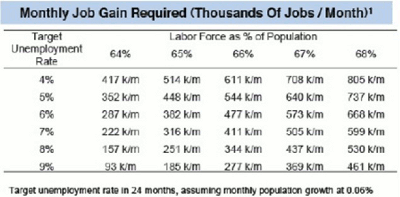What would it take to get the job market back to “normal,” whatever that is? Not what we’ve been trying, that’s for sure, says John Mauldin of Thoughts from the Frontline.
Unless you were completely out of touch last weekend, you know the jobs report came in flat, as in:
- zero
- nada
- “0"
The economy was in neutral, at least as far as employment was concerned. But flat is actually down, as we need 125,000 jobs a month (at least) just to stay up with population growth. And, as we will see, it may well take more than that.
Yes, there was the caveat that 46,000 Verizon workers were on strike, so the number should have been a positive 46,000. But then there were 20,000 returning Minnesota state workers who were “added” back in, so maybe the number should be negative.
As it turns out, workers on strike are counted as unemployed when they go on strike (thus subtracting from the jobs number) and are added as newly employed when they go back to work. So sometime in the next month or so, when those Verizon workers settle, the employment report will show a magic increase of 46,000.
The rules for this are arcane. If you go do the BLS (Bureau of Labor Statistics) Web site—assuming you have no real social life and nothing else better to do—you find that:
Employed persons are “persons 16 years and over in the civilian non-institutional population who, during the reference week, (a) did any work at all (at least 1 hour) as paid employees; worked in their own business, profession, or on their own farm, or worked 15 hours or more as unpaid workers in an enterprise operated by a member of the family; and (b) all those who were not working but who had jobs or businesses from which they were temporarily absent because of vacation, illness, bad weather, childcare problems, maternity or paternity leave, labor-management dispute, job training, or other family or personal reasons, whether or not they were paid for the time off or were seeking other jobs.”
Somehow, strikes don’t count as labor-management disputes. Or personal problems. Go figure. But that is a distortion of the monthly numbers, which is why it is better to look at rolling three-month averages to get a clearer picture.
And speaking of three months, the last three months’ job reports were revised down by a total of 58,000 jobs, making the net over the last three months a very small number.
However you look at this report, it was just ugly. Yet it goes along with regional reports that show a contracting economy and the national ISM (which came out Thursday), which is barely above a contractionary number, at 50.6.
The ugly part of the ISM number is that this was the third straight month in which inventories rose more than new orders. Historically, that suggests we are either in or close to a recession.
The US has roughly the same number of jobs today as it had in 2000, but the population is well over 30 million larger. To get to a civilian employment-to-population ratio equal to that in 2000, we would have to gain some 18 million jobs.
Tonight, 90 minutes before NFL football kicks off, President Obama will give us his latest version of policies to deal with the high unemployment rate. I hope we will hear that he is going to tell federal regulators they have to delete two rules already on the books for every new one they write, but I will not hold my breath.
More green jobs? Why not simply allow energy companies to drill? I could go on, but the real point is that whoever is in the White House, Democrat or Republican, will face an uphill battle.
NEXT: But What Do We Really Need?
|pagebreak|Goldman Sachs (GS) recently released a series of graphs for its hedge-fund clients, talking about ways to play a possible recession, with all sorts of long-short plays, options, spreads, etc. But in that report is a gold mine of data, which they should put up on the Web in some form as a public service (without the suggested trades, because of regulations). It is really one of the better data compilations I have seen in a long time.
One table from that report talks about how difficult it would be to recover from the employment losses of the recession. If anything, the situation has gotten worse than it was two years ago, and even back then it was decidedly not optimistic.
This table shows the number of jobs we would need to create on a consecutive monthly basis to get back to a given level of the labor force as a percentage of population, starting at 64%. We’re barely above 58% now.
Simply to reduce the unemployment rate to 8% over two years at the lowest participation rate of 64% would require 157,000 jobs a month. If those jobs started showing up, the number of people looking for jobs would increase, thus increasing the “official” unemployment rate.
Most of the numbers of required new jobs are simply not possible, if history is any guide. (This is a politician’s nightmare. It will be years before they can take credit for something they didn’t do.)
Of the 30 numbers in the table, historically only six have ever been achieved, and then only in rousing economies. Certainly not in an economy that is at stall speed at best.
The simple fact is that net new jobs for the last 15 years came from business start-ups or rather small businesses, as I have documented previously.
Goldman Sachs notes that, historically, 90% of new jobs come from small businesses, with 75% coming from firms with less than 20 employees. Some of those become Google…but a lot of them are simply small, local services. But every job, if it is yours, is important.
What we need to do is to make it easier for businesses to start and find capital. Reduce the regulatory burden that small businesses face. When small local banks need 1.2 employees to deal with regulations and compliance for every worker they have making loans (as reported in The Wall Street Journal this week), something is seriously wrong.
The sad fact of the matter is that we are in for a long, slow slog uphill on employment for most of the remainder of this decade, until we work through the debt crisis and deal with the deficits.
Subscribe to Thoughts from the Frontline here…
Related Reading:






















